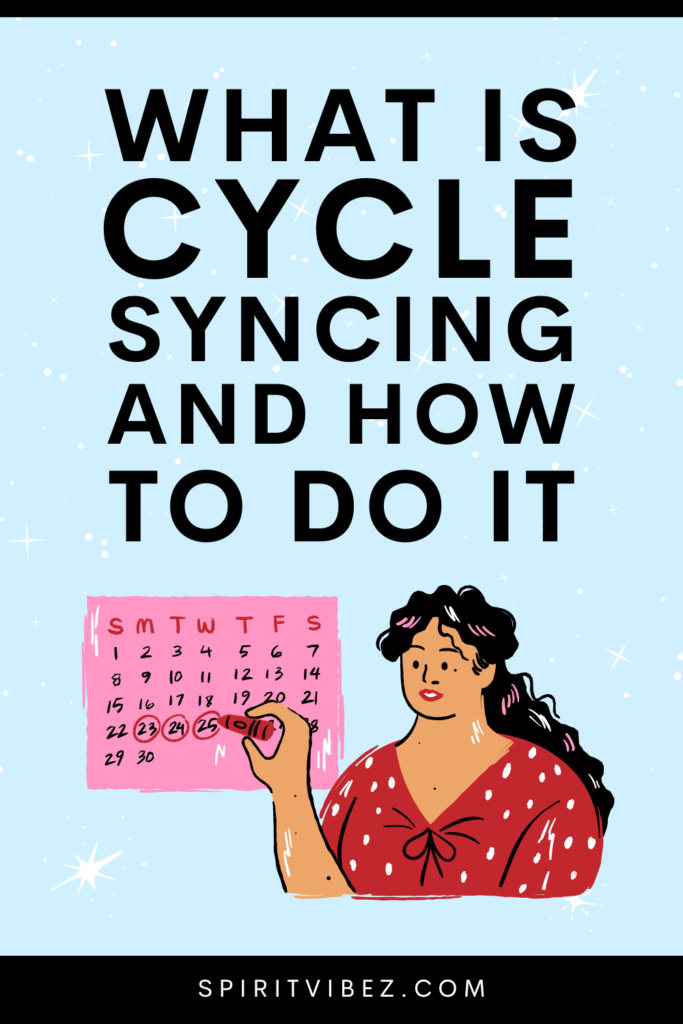Last Updated on August 8, 2023

Life is a mesmerizing journey filled with rhythms and patterns that surround us. Often unnoticed, these natural cycles wield incredible power over our well-being and vitality.
Imagine if you could align yourself with these hidden forces to unlock a newfound sense of harmony and energy. That’s where cycle syncing comes in!
Cycle syncing is an ancient practice that helps us understand how our bodies and minds follow natural cycles, just like the changing seasons.
In this article, you’ll discover what cycle syncing is all about and how you can use it to live a more balanced and happy life.
Whether you’re new to this idea or want to learn more, get ready to unlock the secrets of cycle syncing and discover how you can start benefiting from it in your own life.
What is cycle syncing?
Cycle syncing, also known as menstrual cycle syncing or moon cycle syncing, is a holistic approach that involves aligning various aspects of one’s life with the natural rhythm of their menstrual cycle.
It applies primarily to women who menstruate but it can also be adapted for others in tune with lunar cycles or other natural rhythms.
The menstrual cycle is a complex interplay of hormonal changes that occur in a woman’s body, typically spanning around 28 days. Cycle syncing recognizes that these hormonal fluctuations affect not only reproductive health but also other areas of life, including energy levels, emotions, cognitive abilities, and physical well-being.
By understanding and embracing the different phases of the menstrual cycle, you can tailor your diet, exercise routine, work tasks, and self-care practices to better align with your body’s unique needs during each phase.
The menstrual cycle is typically divided into four main phases. And assigning seasons to each phase of the menstrual cycle can be a helpful way to understand and visualize the changes that occur.
It’s important to note that the concept of seasonality is not an exact science, and individual experiences may vary. However, there’s a general comparison of each menstrual phase to a corresponding season:
1. Menstrual phase
- Season: Inner winter
- When: Around days 1-7
During menstruation, hormone levels are low, and the body is shedding the uterine lining. This phase can be likened to the quiet and restful period of winter.
This phase begins with the start of menstruation. Since hormone levels are relatively low during this time, you’ll often have lower energy levels. Rest and gentle activities may be more appropriate during this phase.
2. Follicular phase
- Season: Inner spring
- When: Around days 8-14
As hormone levels start to rise, the body prepares for potential conception. This phase can be associated with the energy and renewal of springtime.
When your hormone levels begin to rise, it leads to increased energy and creativity. So this is an excellent time for planning and starting new projects.
3. Ovulatory phase
- Season: Inner summer
- When: Around days 14-21
Ovulation is the peak of the menstrual cycle, with hormone levels at their highest. This phase is akin to the vibrant and abundant energy of summer.
Energy levels are high, and communication skills are enhanced, making it an ideal time for socializing and assertive tasks.
4. Luteal phase
- Season: Inner autumn
- When: Around days 22-28
If fertilization doesn’t occur, hormone levels begin to decline, and the body prepares for menstruation. This phase can be related to the reflective and transitional time of autumn.
You may experience premenstrual symptoms. It’s a time for reflection, self-care, and preparation for the next menstrual phase.
Cycle syncing encourages individuals to listen to their bodies and adapt their lifestyles accordingly.
By doing so, they can optimize their physical and emotional well-being, enhance productivity, and cultivate a deeper connection with their natural cycles.
Although research on cycle syncing is ongoing, many individuals report positive effects on their overall health and quality of life by embracing this approach.
What are the benefits of cycle syncing?
Cycle syncing offers several potential benefits for those who choose to align their lifestyle with the natural rhythm of their menstrual cycle.
Benefits of cycle syncing include:
1. Enhanced energy levels: By aligning activities with hormonal changes, experience increased vitality during peak energy phases.
2. Improved mood and emotional well-being: Adapt self-care practices to support emotional balance throughout the menstrual cycle.
3. Hormonal balance: Cycle syncing may promote hormonal equilibrium, benefiting reproductive health and overall well-being.
4. Optimized exercise and fitness: Tailor workouts to leverage high-energy phases and prevent overexertion during menstruation.
5. Enhanced productivity and creativity: Plan tasks during peak cognitive abilities to boost productivity and foster creativity.
6. Improved digestion and nutrition: Adjust diet to cater to changing body needs, improving digestion and nutrient absorption.
7. Better sleep: Syncing sleep routines with hormonal fluctuations can enhance sleep quality and regulate patterns.
8. Heightened self-awareness: Connect with your body and emotions, fostering a deeper understanding of your well-being.
9. Hormone-free birth control awareness: Gain insights into fertile and non-fertile phases for natural family planning.
10. Holistic approach to women’s health: Embrace a comprehensive view of well-being, considering physical and emotional aspects.
How do you eat with cycle syncing?
Eating with cycle syncing involves tailoring your diet to align with the different phases of your menstrual cycle or hormonal rhythms.
The goal is to support your body’s changing needs throughout the month and optimize your overall well-being.
Here are some general guidelines for eating with cycle syncing:
Menstrual phase
- Focus on iron-rich foods to replenish lost nutrients during menstruation (e.g., leafy greens, beans, lentils).
- Incorporate foods high in vitamin B12 to boost energy (e.g., fish, eggs, fortified cereals).
- Stay hydrated with water and herbal teas to ease bloating and cramps.
Follicular phase
- Emphasize fresh fruits and vegetables to provide essential vitamins and antioxidants.
- Include whole grains and complex carbohydrates for sustained energy (e.g., quinoa, brown rice).
- Add lean proteins like poultry, fish, tofu, or legumes to support your body during this phase.
Ovulatory phase
- Increase healthy fats like avocados, nuts, and seeds to support hormone production.
- Enjoy foods with anti-inflammatory properties to reduce potential inflammation (e.g., turmeric, ginger).
- Incorporate colorful fruits and vegetables for a nutrient-rich diet.
Luteal phase
- Prioritize foods rich in calcium to ease PMS symptoms (e.g., dairy, fortified plant-based milk).
- Include magnesium-rich foods to promote relaxation and alleviate cramps (e.g., leafy greens, bananas).
- Opt for complex carbohydrates to stabilize mood and energy levels.
In addition to these general guidelines, listen to your body’s signals and adjust your diet accordingly.
Cravings during certain phases may indicate specific nutrient needs. Embrace a balanced diet, mindful eating, and portion control throughout the month.
It’s essential to remember that cycle syncing is a personalized approach, and not everyone’s menstrual cycle follows the same pattern.
Why is it good to cycle sync your workouts?
Cycle syncing your workouts can be a game-changer for your fitness journey.
By aligning exercise with your menstrual cycle, you optimize energy, support hormonal balance, and benefit from peak performance during certain phases.
It promotes mindfulness, reduces burnout risk, and empowers a personalized approach to fitness. Additionally, it may improve emotional well-being by managing mood fluctuations.
How to workout during each phase of your cycle
Here are some general guidelines on how to tailor your workouts during each phase of your menstrual cycle:
Menstrual phase
- Choose low-impact exercises: Opt for gentle activities like walking, yoga, or stretching to ease cramps and discomfort.
- Listen to your body: Respect your energy levels and give yourself permission to take it easy if needed.
Follicular phase
- Incorporate cardio and strength training: As hormone levels rise, take advantage of increased energy for more intense workouts.
- Focus on endurance and stamina: Engage in activities like running, cycling, or weightlifting.
Ovulatory phase
- High-intensity workouts: With estrogen peaking, go for challenging workouts to make the most of your strength and energy.
- Consider group exercises or team sports to enhance social interactions during this sociable phase.
Luteal phase
- Emphasize stress-reducing exercises: Engage in activities like yoga or pilates to help manage potential PMS symptoms.
- Choose low-impact options if needed: As hormone levels decline, adjust your workouts to support your body’s changing needs.
Remember, these are general guidelines, and everyone’s experience may differ. Always listen to your body and adjust your workouts accordingly.
Cycle syncing after menopause
Cycle syncing after menopause can be an empowering practice, and one alternative approach is lunar cycle syncing.
This method can involve aligning your activities and self-care practices with the phases of the moon, which lasts approximately 29.5 days.
While the menstrual cycle is no longer a factor after menopause, connecting with the moon’s natural rhythms can provide a sense of harmony and mindfulness during this new life stage.
Here’s how lunar cycle syncing can be practiced after menopause:
1. New moon phase: During the new moon, embrace new beginnings and set intentions for the upcoming cycle. Reflect on your goals and aspirations, and consider starting new projects or practices that align with your postmenopausal journey.
2. Waxing moon phase: As the moon grows brighter, focus on growth and progress. This is an excellent time to nurture self-improvement, such as learning new skills or engaging in personal development activities.
3. Full moon phase: Celebrate the full moon’s energy by embracing gratitude and self-appreciation. Engage in activities that promote self-care and emotional well-being, such as meditation, journaling, or spending time in nature.
4. Waning moon phase: As the moon begins to wane, use this time for releasing and letting go. Reflect on any emotional baggage or limiting beliefs that no longer serve you, and practice forgiveness and self-compassion.
Lunar cycle syncing after menopause can be a gentle and intuitive way to embrace the passage of time and find new ways to connect with your inner self.
Remember that this practice is adaptable, and the most important aspect is to honor your unique needs and experiences during menopause and beyond.
Conclusion
Incorporating cycle syncing into your life, whether through traditional menstrual phases or alternative methods like lunar cycle syncing after menopause, can lead to a deeper connection with your body’s innate rhythms.
By embracing this holistic approach, you can nurture your well-being, enhance self-awareness, and embark on a journey of empowerment, all while finding harmony within the natural cycles that surround you.
So, take the time to listen to your body, align your lifestyle with its changing needs, and discover the profound benefits of cycle syncing that await you on this transformative path.
SEE ALSO:
If you enjoyed this post about cycle syncing, I would be grateful if you shared it on Twitter, Facebook, or Pinterest! Thank you❤️
📌 PIN THIS POST FOR LATER


Hello, my name is Sara and I am the founder of Spiritvibez, I’m here to guide you on your spiritual journey toward healing, growth, and self-discovery. I believe that true transformation occurs when the mind, body, and spirit are aligned and working in harmony. Through Spiritvibez, I hope to inspire and empower you to deepen your spiritual practice, embrace your authentic self, and begin living your best life.
